IO流相关知识

IO流
1.文件
保存数据的地方
2.文件流
文件在程序中以流的形式来操作的

流:数据在数据源(文件)和程序(内存)之间的经历的路程
输入流:数据从数据源(文件)到程序(内存)的路程
输出流:数据从程序(内存)到数据源(文件)的路程
3.文件的创建

1.方式一:new File(String pathname)//根据文件路径直接创建
public static void create01() throws IOException {String file="D:\\\\creat01.txt";File file1 = new File(file);file1.createNewFile();System.out.println("文件创建成功");
}
2.方式2:new(File parent,String child)根据父目录文件+子路径
@Test
public void create02() throws IOException {File file = new File("D:\\\\");String children="create02.txt";File file1 = new File(file, children);//执行方法创建文件file1.createNewFile();//file1还在内存中通过createNewFile();才能写入到硬盘中
}
3.new(String parent,String child)根据父目录+子路径构建
//3.new(String parent,String child)根据父目录+子路径构建
@Test
public void create03 () throws IOException {String parent="d:\\\\";String fileName="create03.txt";File file = new File(parent, fileName);file.createNewFile();
}
4.获取文件信息
@Test
//获取文件信息
public void Information(){//创建文件对象File file = new File("D:\\\\create03.txt");
//获取文件名System.out.println(file.getName());//获取绝对路径System.out.println(file.getAbsolutePath());//获得文件的父目录System.out.println(file.getParent());//文件大小 按字节计算System.out.println(file.length());//判断文件是否存在System.out.println(file.exists());//判断是不是一个文件System.out.println(file.isFile());//判断是不是一个目录System.out.println(file.isDirectory());
}
5.目录操作

6.IO流的原理及分类
1.Java Io流原理
1.Input/Output,用于数据传输
2.对于数据的输入和输出操作是以流(stream)的方式进行
3.java.io包下提供各种“流”类和接口
4.输入input:读取外部数据(磁盘)到程序(内存中)
5.输出Output:将程序(内存)数据输出到磁盘等设备
2.流的分类
1.按操作的数据单位不同分为:字节流(8bit)二进制文件,字符流(按字符)文本文件
2.按数据流的流向:输入流和输出流
3.按角色分:节点流、处理流/包装流
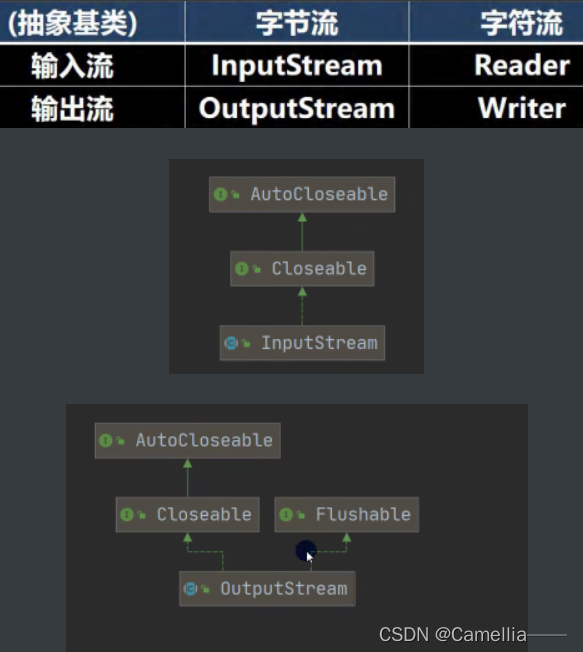
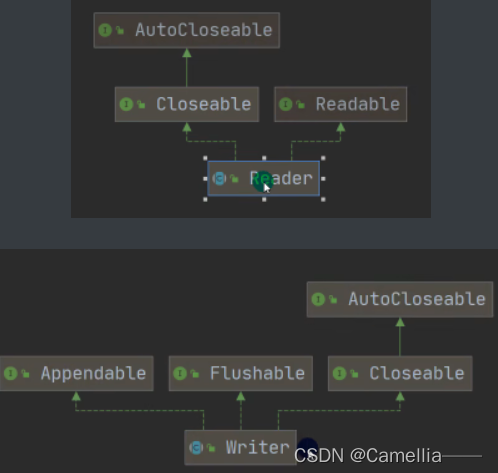
都是抽象类
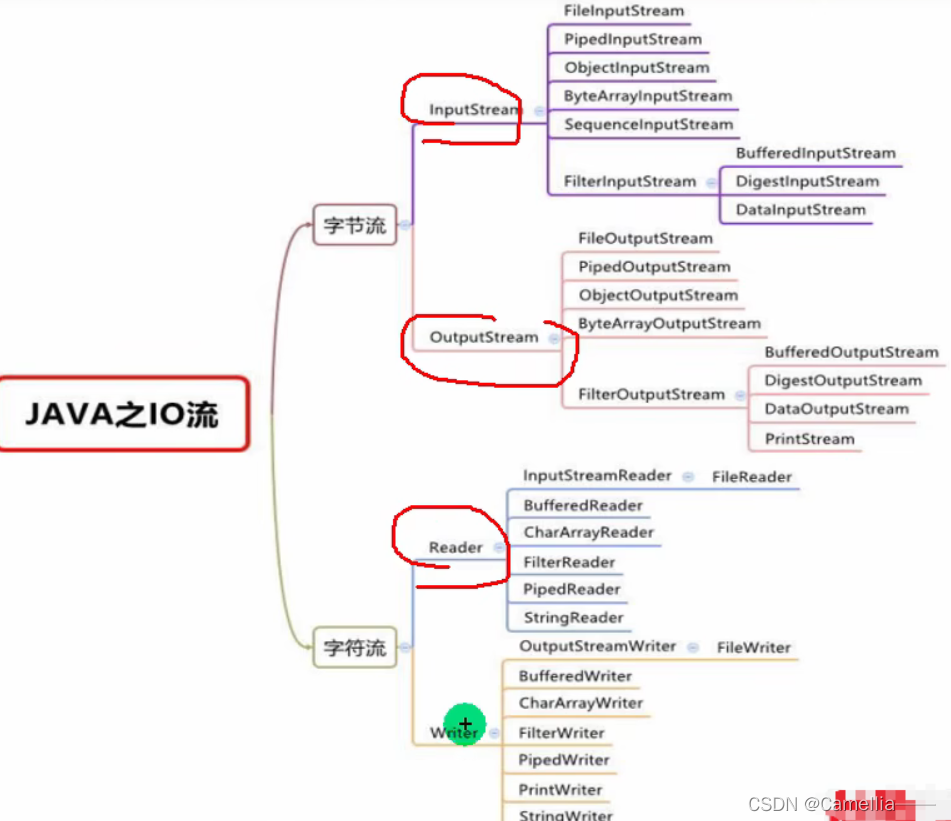
7.InputStream(字节输入流)
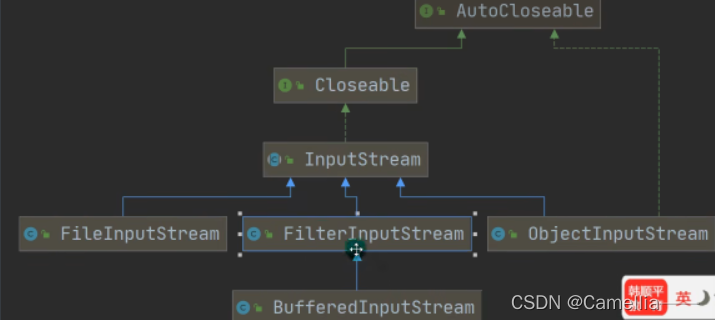
1.FileInputStream
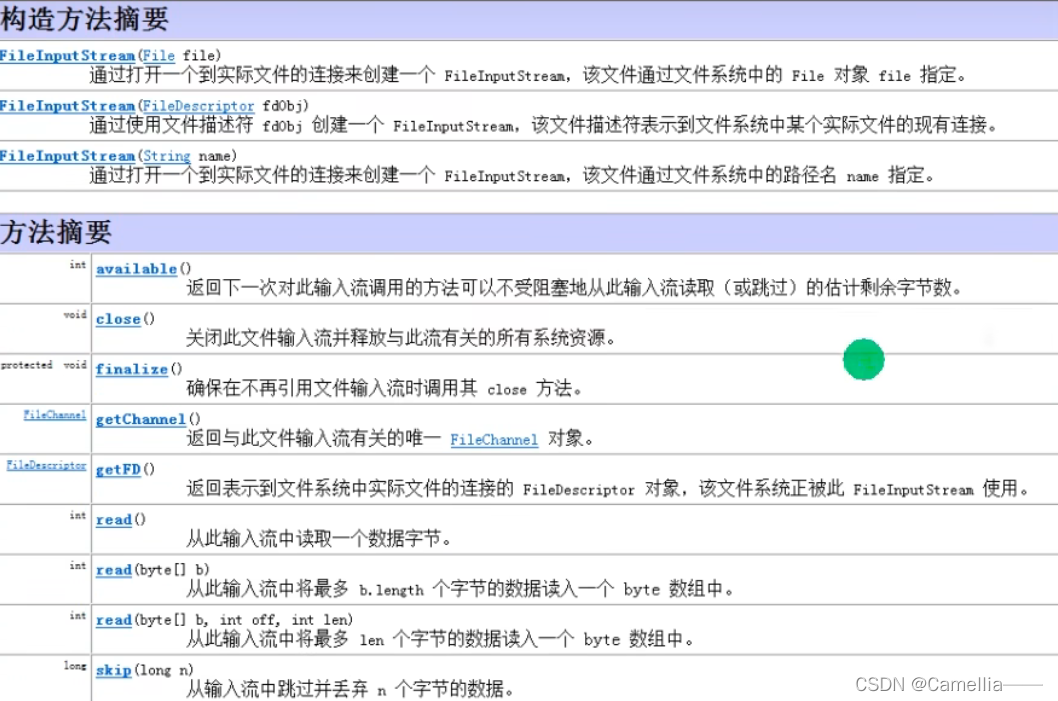
1.读取D:\\hello.txt 单个字节读取
@Test//读取D:\\\\hello.txtpublic void read01() throws IOException{File file = new File("D:\\\\hello.txt");FileInputStream fileInputStream = new FileInputStream(file);int readDate=0;//从此输入流中读取一个数据字节。while ((readDate=fileInputStream.read())!=-1){System.out.printf("%c",(char)readDate);}//关闭文件流释放资源fileInputStream.close();
}
优化
@Test
//读取D:\\\\hello.txt
public void read02() throws IOException{File file = new File("D:\\\\hello.txt");FileInputStream fileInputStream = new FileInputStream(file);int readLen=0;byte [] buf=new byte[8];//从此输入流中将最多 b.length 个字节的数据读入一个 byte 数组中。在某些输入可用之前,此方法将阻塞。while ((readLen=fileInputStream.read(buf))!=-1){//将字节转化为字符串System.out.println(new String(buf,0,readLen));}fileInputStream.close();
}
8.OutputStream(字节输出流)
1.FileOutputStream

@Test public void write01() throws IOException {String path="D:\\\\a.txt";File file = new File(path);//当没有a.txt文件时会自动创建FileOutputStream fileOutputStream = new FileOutputStream(file);fileOutputStream.write('c');System.out.println("写入成功");fileOutputStream.close(); }@Testpublic void write02() throws IOException {String path="D:\\\\a.txt";File file = new File(path);String str="hello";//当没有a.txt文件时会自动创建//不会将之前的文件内容覆盖,而是在之前文件内容后面追加FileOutputStream fileOutputStream = new FileOutputStream(file,true);fileOutputStream.write(str.getBytes(),0,str.length());System.out.println("写入成功");fileOutputStream.close();}
9.文件拷贝
//将D:\\\\1.png 拷贝到E盘
@Test
public void fileCopy() throws IOException {//创建路径String srcPath="D:\\\\1.png";String destPath="E:\\\\1.png";//创建文件输入流对象FileInputStream fileInputStream = new FileInputStream(srcPath);//创建文件输出流对象FileOutputStream fileOutputStream = new FileOutputStream(destPath);//定义一个字节提高读取效率byte []buf=new byte[1024];int readLen=0;while((readLen=fileInputStream.read(buf))!=-1){//一边读一边写fileOutputStream.write(buf,0,readLen);}System.out.println("拷贝完毕");//关闭资源if(fileInputStream!=null){fileInputStream.close();}if (fileOutputStream!=null){fileOutputStream.close();}
}
10.文件字符流的说明
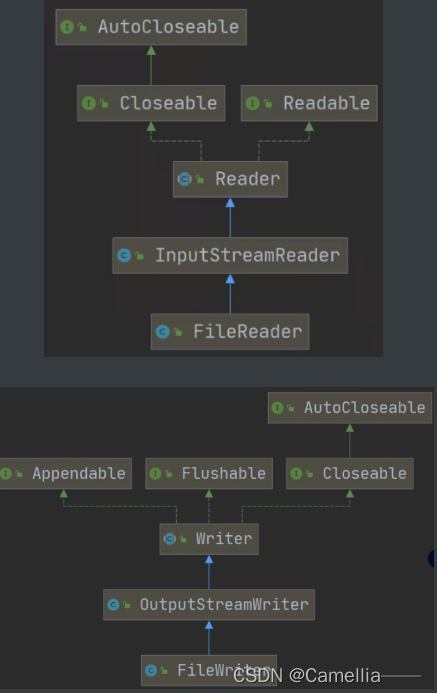
注意:FileWriter使用后,必须要关闭(close)或者刷新(flush),否则写入不到指定的文件
11.FileReader
//读取test.txt 编码格式为UTF-8 @Test public void testReader() {//创建读取路径String path="D:\\\\test.txt";FileReader fileReader = null;//通过一个字符一个字符的读取int data=0;try {fileReader = new FileReader(path);while ((data=fileReader.read())!=-1){System.out.print((char)data);} } catch (IOException e) {e.printStackTrace();}finally {//关闭资源try {fileReader.close();} catch (IOException e) {e.printStackTrace();}}System.out.println("读取ok"); }@Test public void testReader2() {//创建读取路径String path = "D:\\\\test.txt";FileReader fileReader = null;int len = 0;char[] buf = new char[8];try {fileReader = new FileReader(path);while ((len = fileReader.read(buf)) != -1) {System.out.print(new String(buf, 0, len));} } catch (IOException e) {e.printStackTrace();} finally {//关闭资源try {fileReader.close();} catch (IOException e) {e.printStackTrace();}}System.out.println("读取ok"); }
12.FileWriter
@Test
public void testWriter() throws IOException {String path="D:\\\\note.txt";FileWriter fileWriter = new FileWriter(path,true);fileWriter.write("风雨过后就是彩虹");//FileWriter使用后,必须要关闭(close)或者刷新(flush),否则写入不到指定的文件fileWriter.close();
}
13.节点流和处理流
1.节点流可以从一个特定的数据源读写数据,如FileWriter、FileReader
2.处理流(也叫包装流)是”连接“在已存在的流(节点流或处理流)之上,为程序提供更强大的读写功能。BufferedReader类中,有属性Reader,即可以封装一个节点流,该节点流是可以任意的,只要是Reader子类

节点流和处理流的区别和联系
1.节点流是底层流/低级流,直接跟数据源相连接
2.处理流(包装流)包装节点流,既可以消除不同节点流之间的差异,也可以提供更方便的方法来完成输入、输出
3.处理流(包装流)对节点流进行包装,使用了修饰器设计模式,不会直接与数据源相连
处理流的功能主要体现在以下两个方面
1.性能高:主要以增加缓冲的方式来提高输入、输出的效率
2.操作便捷:处理流可以提供一系列便捷的方法来一次输入、输出大批量的数据,使用方便更加灵活
14.BufferReader
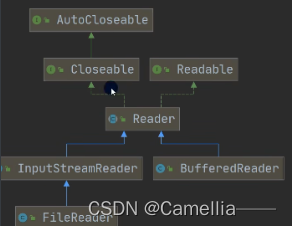
1.按行读取
@Test
public void testBufferReader() throws IOException {String path="D:\\\\test.txt";FileReader file = new FileReader(path);BufferedReader bufferedReader = new BufferedReader(file);//进行按行读取String line;while((line=bufferedReader.readLine())!=null){System.out.println(line);}//关闭资源,底层会自动关闭节点流bufferedReader.close();
}
15.BufferWriter
@Test
public void test01() throws IOException {String path="D:\\\\note.txt";/*public void newLine()throws IOException 写如一行*/FileWriter fileWriter = new FileWriter(path);BufferedWriter bufferedWriter = new BufferedWriter(fileWriter);bufferedWriter.newLine();//写入一个行分隔符。行分隔符字符串由系统属性 line.separator 定义,并且不一定是单个新行 ('\\n') 符。bufferedWriter.write("hello",0,2);//关闭资源bufferedWriter.close();
}
16.Buffer拷贝
不要去操作二进制文件如声音、视频、二进制文档 如果操作会造成文件损坏
/*
* 将D:\\\\test.text拷贝到E:\\\\test.text
* */
@Test
public void copy() throws IOException {String srcPath="D:\\\\test.txt";String destPath="E:\\\\test.text";FileReader fileReader = new FileReader(srcPath);FileWriter fileWriter = new FileWriter(destPath);BufferedReader bufferedReader = new BufferedReader(fileReader);BufferedWriter bufferedWriter = new BufferedWriter(fileWriter);String line;//按行读取while((line=bufferedReader.readLine())!=null){//每次写之前前进行换行bufferedWriter.newLine();bufferedWriter.write(line);
}//关闭资源if (bufferedWriter!=null){//bufferedWriter不等于null,才有关闭流的可能;一定要对此进行判断bufferedWriter.close();}if (bufferedReader!=null){bufferedReader.close();}System.out.println("拷贝完毕");
}
17.字节处理流
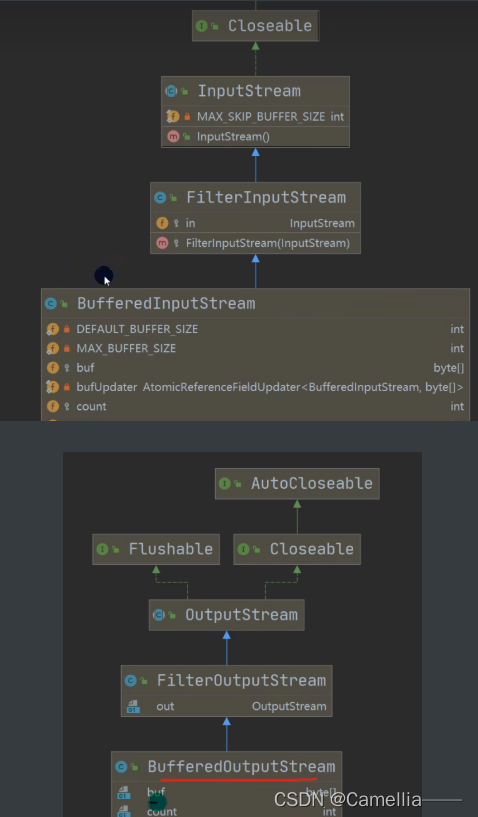
二进制文件的拷贝
/* 对二进制文件进行处理将D:\\Love Story.m4a拷贝到E:\\Love Story.m4a
*/
@Test
public void copy() throws IOException {String src="D:\\\\Love Story.m4a";String dest="E:\\\\Love Story.m4a";FileInputStream fileInputStream = new FileInputStream(src);FileOutputStream fileOutputStream = new FileOutputStream(dest);BufferedInputStream bs = new BufferedInputStream(fileInputStream);BufferedOutputStream bo=new BufferedOutputStream(fileOutputStream);int data=0;byte[]buf=new byte[8];while ((data=(bs.read(buf)))!=-1){bo.write(buf);}if(bs!=null){bs.close();}if(bo!=null){bo.close();}
}
18.对象流
ObjectInputStream和ObjectOutputStream
序列化和反序列化
1.序列化:在保存数据时,保存数据的值和保存数据的类型
2.反序列化:在恢复数据时,恢复数据的值和类型
3需要让某个对象支持序列化机制,则必须让其可序列化,该类必须实现两个接口之一: Serializable//这是一个标记接口,没有方法
Externalizable//该接口有实现方法
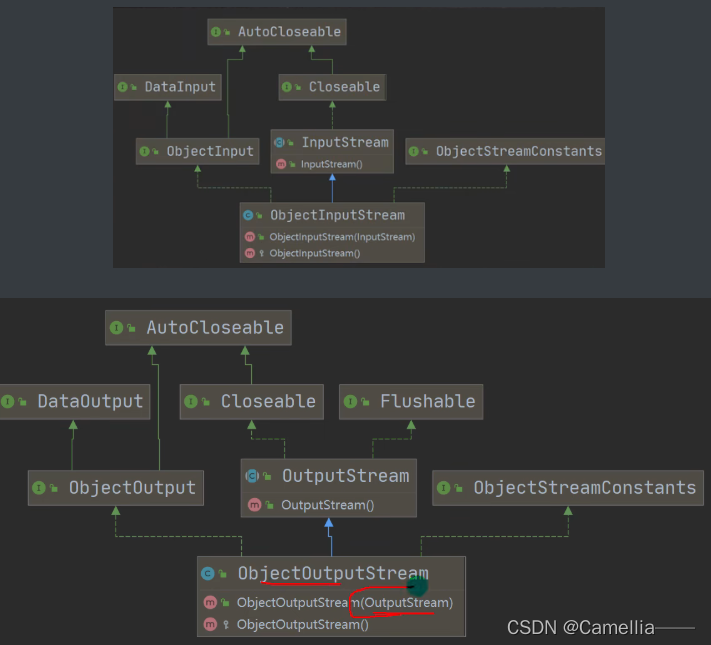
1.ObjectOutPutStream
public static void main(String[] args) throws IOException {//序列化数据到data.txtString pathClass="D:\\\\data.txt";//节点流 直接操作数据FileOutputStream fileOutputStream = new FileOutputStream(pathClass);//包装节点流ObjectOutputStream oos = new ObjectOutputStream(fileOutputStream);oos.write(100);//int=>Integer(Integer实现了Serializable)oos.close();}
2.ObjectInputStream
public static void main(String[] args) throws IOException {//反序列化的文件String pathClass="D:\\\\data.txt";FileInputStream fileInputStream = new FileInputStream(pathClass);ObjectInputStream ois = new ObjectInputStream(fileInputStream);//读取反序列化的顺序要和你保存反序列化的顺序一致System.out.println(ois.readInt());ois.close();
}
3.注意事项
1.序列化和反序列化时读写顺序一致
2.要求序列化或反序列化对象,需要实现Serializable
3.序列化的类中建议添加SerialVersionUID,为了提高版本的兼容性
4.序列化对象时默认将里面的所有属性都进行序列化,但除了static或transient修饰的成员
5.序列化对象时要求属性的类型也需要实现序列化接口
6.序列化具备可继承性,也就是如果某类已经实现了序列化,则他所有的子类已经默认实现序列化
19.标准输入输出流

标准输入流:
编译时期:InputStream 运行时期:BufferInputStream
20.转换流
可以解决乱码问题,指定编码方式
1.InputStreamReader:Reader的子类,可以将InputStream(字节流)包装成(转换)Reader(字符流)
//将fileInputStream转换成InputStreamReader
public class InputStreamReader_ {public static void main(String[] args) throws IOException {String path="E:\\\\a.txt";//将FileInputStream转化成InputStreamReader//设置对应的编码集InputStreamReader isr = new InputStreamReader(new FileInputStream(path), "gbk");BufferedReader bufferedReader = new BufferedReader(isr);//读取String line = bufferedReader.readLine();//关闭外层流System.out.println(line);bufferedReader.close();}
}
2.OutPutStreamWriter:Writer的子类,实现OutputStream(字节流)包装成Writer(字符流)
3.当处理纯文本数据时,如果使用字符流效率更高,并且可以有效解决中文问题
public class OutputStreamWriter_ {public static void main(String[] args) throws IOException {String path="E:\\\\b.txt";FileOutputStream fileOutputStream = new FileOutputStream(path);OutputStreamWriter ost = new OutputStreamWriter(fileOutputStream, "gbk");BufferedWriter bw = new BufferedWriter(ost);bw.write("你好李焕英");System.out.println("ok");//关闭外层资源bw.close();}
}
4.可以在使用时指定编码格式
21.打印流
PrintStream和PrintWriter
public class PrintStream_ {public static void main(String[] args) throws IOException {PrintStream out=System.out;//在默认情况下,PrintStream输出数据的位置是显示器/*public void print(String s) {if (s == null) {s = "null";}write(s);}*/out.print("hello ");//因为print底层使用的是write,所以我们可以直接调用writer进行打印输出out.write("hello".getBytes());out.close();//可以去修改打印流输出的位置/ 1.输出修改到"E:\\\\t.txt"* 2."hello"也会输出到"E:\\\\t.txt"* 3. public static void setOut(PrintStream out) {checkIO();setOut0(out);}* */System.setOut(new PrintStream("E:\\\\t.txt"));System.out.println("hello");
}
}
public class PrintWriter_ {public static void main(String[] args) throws IOException {PrintWriter writer = new PrintWriter(new FileWriter("E:\\\\t2.txt"));writer.print("hello");writer.close();//flush+关闭流,才会将数据写入到文件}
}
22.properties

1.文件格式
键值对形式存在
2.注意
键值对不需要有空格,值不需要用引号引起来,默认类型是String
3.常见方法

public class Properties_ {public static void main(String[] args) throws Exception {//使用properties读取文件//加载该文件Properties pro = new Properties(); pro.load(new FileReader("src\\\\jdbc.properties")); // 输出pro.list(System.out);//根据key获取valueString property = pro.getProperty("jdbc.url");System.out.println(property);} }public class Properties_2 {public static void main(String[] args) throws IOException {//Properties底层是HashTable//创建properties文件Properties properties = new Properties();properties.setProperty("hello","45");properties.setProperty("1","123");//第二个参数指的是生成文件注释properties.store(new FileWriter("src\\\\jdbc2.properties"),null);System.out.println("创建完毕");} }


